博文
[转载]20%中国人死于吃错饭!《柳叶刀》发布全球吃饭报告
||| |
20%中国人死于吃错饭!《柳叶刀》发布全球吃饭报告
当地时间2019年4月3日,《柳叶刀》发布了全球饮食领域的首个大规模重磅研究——195个国家和地区饮食结...

恰饭真的是个技术活……
作者|姜飞熊
来源|医学界妇产科频道
当地时间4月3日,《柳叶刀》发布了全球饮食领域的首个大规模重磅研究——195个国家和地区饮食结构造成的死亡率和疾病负担。

这项统计时间跨度近30年的大型研究不仅前所未有,还得出了不少让人震惊的结论,其中包括:中国因为饮食结构而导致的死亡率和疾病发生率,竟然比美国高了许多!
毕竟,在大家的印象中,美国是个“万物皆可炸”各种高糖高油饮食的国家,我们竟然能比他们还不健康,也是很让人害怕了……
恰饭,也是个危险的技术活啊。
1
中国是恰饭思路错误的重灾区
先来看看因饮食结构问题引发的死亡率的世界形势图——
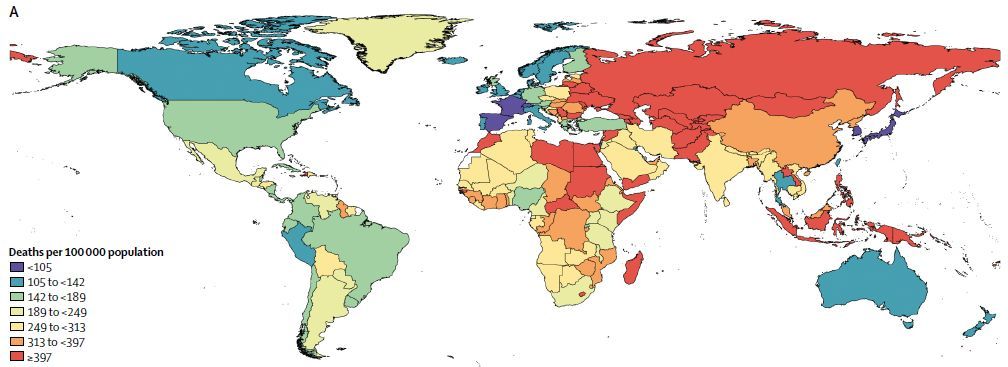
紫色块是地球上饮食结构引发死亡率最低的区域,实际上,虽然都是紫色,我们旁边的日本和韩国是真正在数值上最低的区域,比欧洲的紫色地区更低。
中国处于倒数第二档,橙色块,看上去似乎比蒙古和俄罗斯等橙红色国家好些。但是……2017年的统计结果显示,并没有好多少。
《柳叶刀》在原文中连cue中国两次,指出,在2017年的统计中,中国因为饮食结构问题造成的心血管疾病死亡率、癌症死亡率都是世界人口前20的大国中的第一名……

《柳叶刀》原文
而同在东亚的日本却有着最低的饮食结构造成的全因死亡率、心血管疾病死亡率和糖尿病死亡率。
2
最大杀手竟然不是糖和脂肪
这次的统计给出了一个与我们日常刻板印象完全不同的颠覆性结果,全球范围内每年造成上千万人死亡的错误饮食习惯并不是糖和油脂吃太多,而在于钠、杂粮和水果——
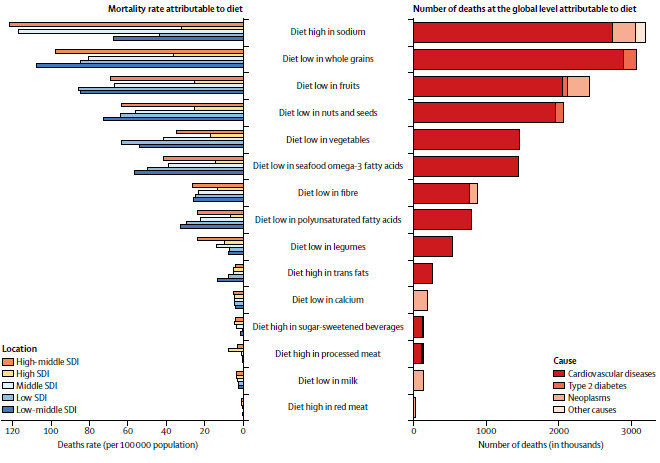
因为饮食结构问题导致死亡的统计表,前三位分别是高盐、低杂粮和低水果饮食
据《柳叶刀》统计,光是2017年一年,因为高钠饮食而死亡的人口就有300万,因为杂粮吃太少而死亡的也有300万,还有200万因为水果没吃够而亡,全球近20%的死亡案例是饮食问题导致的,在中国,这个比例更高。
而那些被我们日常警惕的红肉、加工肉类、含糖饮料甚至反式脂肪,反而在死亡贡献里排行靠后。即便在DALY(失能调整生命年,用于衡量整体疾病负担)统计中,它们的排名也是靠后的……
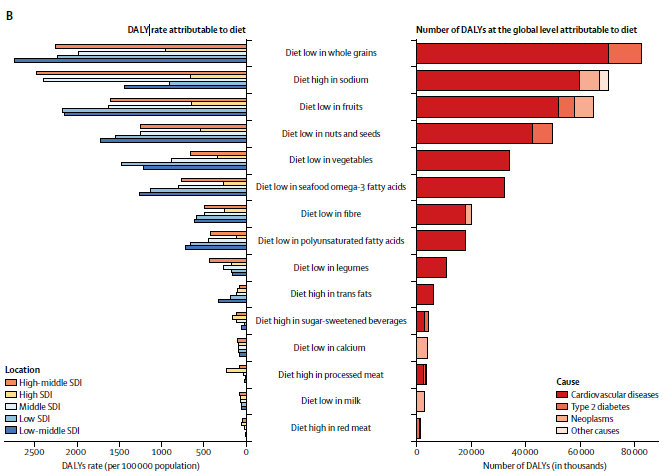
造成疾病负担的前三位顺序略有调整,但还是那仨:低杂粮饮食、高钠饮食和低水果饮食。
饮食结构问题造成的主要疾病有三:心血管疾病、肿瘤和2型糖尿病。也主要是这三种疾病最终导致了大家因为恰饭方案不正确而死亡。
3
中国的高死亡率主要是为什么
《柳叶刀》统计了不同地区的各项饮食状况达标情况,其中,东亚地区因为将日韩单独计入了“高收入亚太地区”板块,所以基本上可以视为以中国为主的数据。
1.首先来看一下致死重灾区,钠超标——

第二个一骑绝尘的紫色条是东亚的数据,基本上可以看做中国的数据……最顶上的灰色条代表全球平均水平。虚线代表底线,绿色线和区间是最佳推荐区间。
第二条是唯一一个彻底击穿底线的,也是全球最严重的钠摄入过多重灾区。而高钠饮食作为杀手榜上第一把交椅,导致中国连续在死亡率上被cue,似乎也不奇怪了。
顺便说一下,红色条第一条是日韩等亚太地区高收入国家,在控制钠摄入方面,他们其实是倒数第二,仍需努力。
2.水果不足要命——
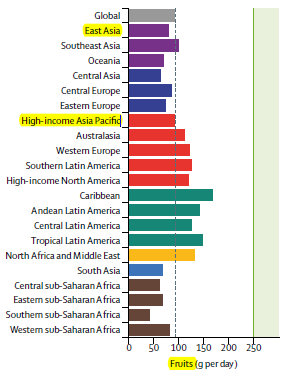
在每日水果摄入量方面,东亚数据依然疲软,没达到及格线(虚线推荐的每天100g),更别说最佳推荐量250g了。不过全世界各地区都没达到最佳推荐量……
日韩等高收入邻国勉强达到了及格线。
3.杂粮量也没及格……
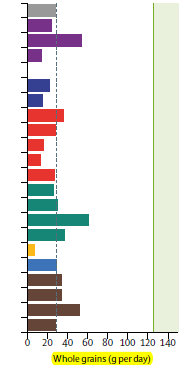
和水果一样,数据显示,咱们杂粮摄入量也低于及格线,第三条超过的是东南亚地区,日韩地区这次过了及格线。
同样,全球都没达到推荐最佳摄入量,离绿线远着呢。
看完上面三个,可能大家会有点奇怪,日韩也没和我们天差地别嘛怎么就是我们死亡率最高日本死亡率最低了呢?
有相当大的原因可能在下面这张图里……

这张图是每日摄入omega-3脂肪酸的统计,唯一一个飙进绿色区域还超过表格上限的那条红色条,就是日韩的数据。
在这方面,他们轻松的超过了澳大利亚、西欧和北美,更不要说离及格线还远得很的中国了……
而且其实在少吃加工肉类、少喝含糖饮料和少吃反式脂肪方面,日韩做得比中国要差一些,见下图——
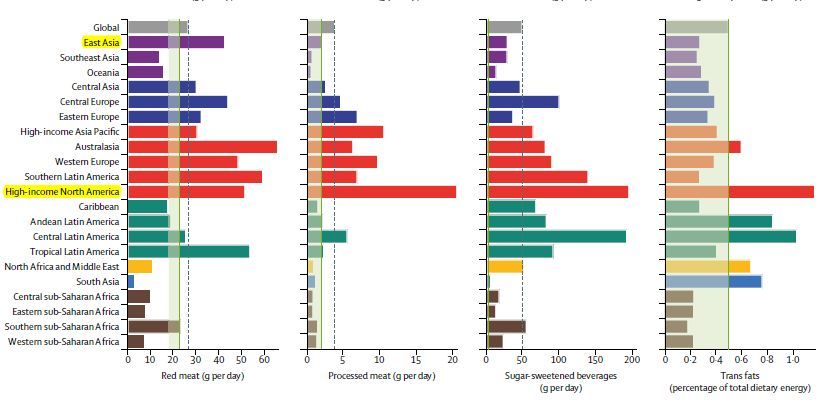
从左到右四张表,分别统计的是红肉、加工肉类、含糖饮料、反式脂肪的平均每日摄入量,除了红肉中国数据较高外,其他三项中国都比日韩为主的高收入亚太地区数据低。
顺带一提,最后一个红色条是高收入北美地区,每项都比中国更高,但是他们的饮食结构造成的死亡率和疾病负担比中国少。
4
那么应该怎么吃
知道原因了,对症纠错也不难。《柳叶刀》甚至在文章中直接附上了各种食物的推荐量,大家完全可以照着计划一下。

《柳叶刀》恰饭方法分析表,标亮部分是三大杀手的条目
首先,低钠!低钠!低钠!
我们饮食中的钠摄入,大部分来自食用盐。所以,少吃盐,有意识的避开过咸的食物,做饭少放盐,能大大降低钠盐摄入。
《中国居民膳食指南(2016)》推荐每日摄入盐少于6g,柳叶刀表中要求更严格,认为最佳标准在3g左右。
根据《柳叶刀》的统计,中国居民每日摄入盐的平均量在8g以上,《中国居民膳食指南解读》中则提到,2012年的统计调查显示,中国居民每日摄入盐的平均量在10.5g……远远超过3g!
其次,多吃水果。
《柳叶刀》对水果的推荐量是每日250g左右,也就是说每天要吃半斤,大家加油吃。
再次,杂粮替代精米白面。
每天125g杂粮看着不多,但是全球各区域竟然都差得远这就很惊人了。对于中国人来说,将食物中的精米和白面替换为杂粮应该是可以接近这个目标的,而且精米白面在饮食健康方面评价就不高。
最后,不要对其他不健康因素放松警惕。
看到红肉、反式脂肪、含糖饮料在杀人榜上排行靠后,一些想要快乐的宅宅们是不是心思又活络起来了……
大家还是要坚持原有的健康习惯,正确的恰饭,好好锻炼。

毕竟,偶尔快乐偶尔爽,一直快乐火葬场。
参考文献:
https://dx.doi.org/10.1016/S0140-6736(19)30041-8
http://dx.doi.org/10.1016/S0140-6736(19)30500-8
《中国居民膳食指南(2016)》
http://dg.cnsoc.org/article/04/8a2389fd5520b4f30155be1475e02741.html
类似的研究结果:
Millions of cardiovascular deaths attributed to not eating enough fruits and vegetables
Millions of cardiovascular deaths attributed to not eating enough fruits and vegetables
 Percentage of cardiovascular deaths (cardiovascular disease mortality) attributable to suboptimal vegetable intake (less than 400 grams per day) in countries around the world. Credit: Global Dietary Database 2010/Friedman School of Nutrition Science & Policy at Tufts University
Percentage of cardiovascular deaths (cardiovascular disease mortality) attributable to suboptimal vegetable intake (less than 400 grams per day) in countries around the world. Credit: Global Dietary Database 2010/Friedman School of Nutrition Science & Policy at Tufts University
Preliminary findings from a new study reveal that inadequate fruit and vegetable consumption may account for millions of deaths from heart disease and strokes each year. The study estimated that roughly 1 in 7 cardiovascular deaths could be attributed to not eating enough fruit and 1 in 12 cardiovascular deaths could be attributed to not eating enough vegetables.
Low fruit intake resulted in nearly 1.8 million cardiovascular deaths in 2010, while low vegetable intake resulted in 1 million deaths, according to researchers. Overall, the toll of suboptimal fruit intake was almost double that of vegetables. The impacts were most acute in countries with the lowest average intakes of fruits and vegetables.
"Fruits and vegetables are a modifiable component of diet that can impact preventable deaths globally," said lead study author Victoria Miller, a postdoctoral researcher at the Friedman School of Nutrition Science and Policy at Tufts University. "Our findings indicate the need for population-based efforts to increase fruit and vegetable consumption throughout the world."
Miller will present the research findings at Nutrition 2019, the American Society for Nutrition annual meeting, held June 8-11, 2019 in Baltimore.
Fruits and vegetables are good sources of fiber, potassium, magnesium, antioxidants and phenolics, which have been shown to reduce blood pressure and cholesterol. Fresh fruits and vegetables also improve the health and diversity of good bacteria in the digestive tract. People who eat more of these foods also are less likely to be overweight or obese, lowering their risk of cardiovascular disease.
"Global nutrition priorities have traditionally focused on providing sufficient calories, vitamin supplementation and reducing additives like salt and sugar," said senior study author Dariush Mozaffarian, dean of the Friedman School of Nutrition Science and Policy at Tufts University. "These findings indicate a need to expand the focus to increasing availability and consumption of protective foods like fruits, vegetables and legumes—a positive message with tremendous potential for improving global health."
 The percentage of cardiovascular deaths (cardiovascular disease mortality) attributable to suboptimal fruit intake (less than 300 grams per day) in countries around the world. Credit: Global Dietary Database 2010/Friedman School of Nutrition Science & Policy at Tufts University
The percentage of cardiovascular deaths (cardiovascular disease mortality) attributable to suboptimal fruit intake (less than 300 grams per day) in countries around the world. Credit: Global Dietary Database 2010/Friedman School of Nutrition Science & Policy at Tufts University
Based on dietary guidelines and studies of cardiovascular risk factors, the researchers defined optimal fruit intake as 300 grams per day, equivalent to roughly two small apples. Optimal intake of vegetables, including legumes, was defined as 400 grams per day, equivalent to about three cups of raw carrots.
The researchers estimated average national intakes of fruit and vegetables from diet surveys and food availability data representing 113 countries (about 82 percent of the world's population), then combined this information with data on causes of death in each country and data on the cardiovascular risk associated with inadequate fruit and vegetable consumption. The work is part of the Global Dietary Database project funded by the Bill & Melinda Gates Foundation.
Based on data from 2010, the scientists estimated that suboptimal fruit consumption results in nearly 1.3 million deaths from stroke and more than 520,000 deaths from coronary heart disease (narrowing of the heart's arteries) worldwide each year. Suboptimal vegetable consumption was estimated to result in about 200,000 deaths from stroke and more than 800,000 deaths from coronary heart disease.
The impact of inadequate fruit and vegetable intake was greatest in countries with the lowest fruit and vegetable consumption. Countries in South Asia, East Asia and Sub-Saharan Africa had low fruit intake and high rates of associated stroke deaths. Countries in Central Asia and Oceania had low vegetable intake and high rates of associated coronary heart disease.
In the United States, suboptimal vegetable intake may account for 82,000 cardiovascular deaths while suboptimal fruit intake accounted for 57,000 deaths. Cardiovascular disease is the number one cause of death in the United States and worldwide.
By age group, suboptimal fruit and vegetable intake had the greatest perceived proportional impact on cardiovascular disease deaths among younger adults. By gender, suboptimal fruit and vegetable intake had the greatest proportional impact on cardiovascular disease deaths in men, likely because women tend to eat more fruits and vegetables, Miller noted.
https://blog.sciencenet.cn/blog-212210-1184232.html
上一篇:再补几张百合花
下一篇:花无百日红